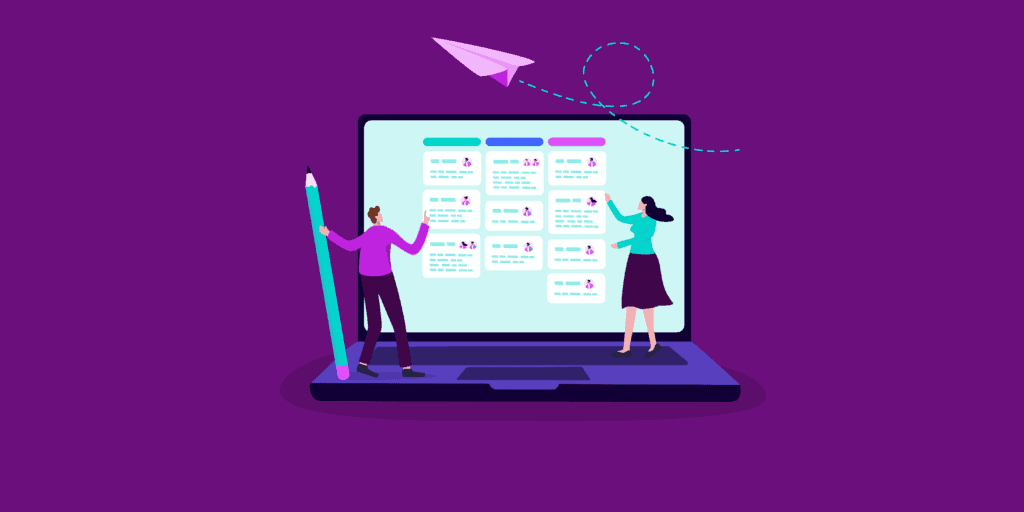“Every single function that goes into preparing and winning proposals is extremely important. It’s frankly one of the only ways a business can sustain its size and grow,” says Hayley Watkins, Co-founder of Summit Strategy.
But it’s easier said than done. While the proposal management process starts with great ambitions and intentions, it often spins out of control quickly. Do either of these scenarios sound familiar to you?

#1 Scenario to Avoid: The Proposal Maze
Your RFP team knows the end goal (to win), but getting there is a circuitous mystery. There are many twists and turns in the RFP requirements, roadblocks to gathering answers from subject matter experts (SMEs), and shared file drives and email threads to get lost in.

#2 Scenario to Avoid: The Proposal Mess
In this scenario, the only commonality that exists from one RFP to another is that it’s a chaotic free-for-all every time. By the end of the proposal process, your RFP team doesn’t care if they win or not—they’re just happy when the response is finally submitted.
These two ends of the spectrum don’t paint a pretty picture, but there’s a better option for proposal teams…
In fact, Hayley and Summit Strategy’s other Co-founder, Krystn Macomber, built a proposal management process that’s simple, tailorable, and ultimately helps their diverse client base win more work—from federal contractors to woman-owned small businesses. It’s a process the duo has coined, Your Strategic EdgeTM.
In this article, you’ll learn how to use their integrated marketing and proposal approach to create an RFP response process that’s easy to follow—and scales. Here are the five P’s you can take to win:
1. Plan: Truly Understand Your Market
Proper planning requires alignment with your end goal from the beginning. So, this is where you get to know your market, figure out your Strengths, Weaknesses, Opportunities, and Threats (SWOT), identify target clients, and write a business plan.
Your proposal process doesn’t have to be complex because your buyers are complex. People want to work with people they trust. So, it’s really about focusing on the most important element: What you can do for them.

✓ Carry out a SWOT analysis: As any proposal team knows, things change quickly every year. A good SWOT analysis allows you to ask tough questions: Are you reaching your full potential as a team? How is the market changing? Are you adapting in the ways you need to succeed? Where are competitors encroaching on your business?
✓ Be realistic about your target clients: No business can go after everyone. Think about what ideal characteristics describe your ideal client and what truly matters to your business. For example, is it more important to look for clients who are a culture fit or in a growth stage?
✓ Write your business plan: The format of your business plan doesn’t matter; just make sure to include a market analysis, key clients and pursuits, growth strategies, and your marketing plan.
2. Position: Leverage Marketing for Your Pursuit Strategy
With a plan in your back pocket, you can move on to positioning. At this stage, proposal and marketing teams should work together to solidify leadership in the space—and ensure the online world backs it up.
For example, if your sales team is pursuing an opportunity, look at what’s in your marketing toolbox that you can employ and put in front of that audience so that you’re already a hot commodity when the RFP is released. Think blog posts, case studies, or any collateral that talks about the services you offer.
Then ask five key questions to nail down a strong and unique position:
- What do we know about the opportunity?
- Who do we have relationships with?
- Who is our team, and where have we done this before?
- What’s our win strategy?
- How can we leverage marketing channels?
3. Propose: Craft a Winning RFP Response
Once you receive an RFP, you can jump right into crafting your response. Right? Wrong. First, you need to decide whether the RFP is actually worth pursuing. As Krystn says, “Gone are the days of closing the deal at any cost. You have to chase and close the right deal, not just any deal.”
So, invite your key stakeholders to a go/no-go meeting for a lively discussion about the opportunity. Give everyone a chance to share their thoughts, ask tough questions, and don’t settle for lukewarm answers, like, “We don’t know the client’s hot buttons, but we think we can win.” Instead, be firm about your RFP evaluation criteria (which you should revisit as your company, client needs, and pipeline change).
When you are confident about the opportunity, you can carry out the rest of the RFP process steps.
✓ Define your win themes: Use the Issues, Features, Benefits, and Proofs (IFBP) formula to get to the heart of your client’s pain points and how you can uniquely solve them. (Psst…if you get stuck on the Issues column, that’s a surefire sign to re-evaluate your go/no-go criteria.)
✓ Lean on your content library: Your content is the foundation of your RFP response, and being able to access it quickly will help you spend more time tailoring every answer for the opportunity—rather than digging around for documents and presentations.
✓ Schedule regular reviews: Make sure your proposal is heading in the right direction by checking in throughout the process. At the halfway mark, look to see if your content is on point and address any gaps. When it’s 95% complete, bring your story together (messaging and visuals). Then in the final QA, get as many eyes on it as possible to identify fatal flaws and critical errors.
4. Persuade: Wow Your Client in the Interview
You submitted the proposal, made the shortlist, and now it’s time for the RFP finalist presentation (also known as the interview). Here’s where you can either win or lose—no matter the position you had going in. So, even if your team has interviewed together a million times, you still need to practice.
You win or lose in practice. If you aspire to be a winning team, then you have to do what it takes to put on a great performance.

So, finish your content early, allow plenty of time for rehearsal, and come together as a gelled team.
✓ Conduct a kickoff meeting: Like the beginning of the proposal management process, you should also host a kickoff meeting for the interview. In this meeting, it’s important to go over who needs to be in attendance (and whether they can handle the pressure), come up with a creative delivery (think format and materials), and prepare for any questions the client might ask.
✓ Do your homework: Research what’s going on with the client lately to find common ground or understand their state of mind coming into the interview. This homework can involve a simple Google search, poking around LinkedIn, or contacting your network for intel.
✓ Rehearse, rehearse, rehearse: And then rehearse some more. “But not to the point of over-rehearsing,” Hayley says, “It’s more about coaching, and making sure the presenters feel comfortable and confident in front of the client.
5. Promote: Celebrate Your Win 🎉
Hooray! You’ve won the RFP. But the work doesn’t stop here. As Krystn explains, “You want to take time to go back to your marketing tactics and make sure you promote that win, provided you can talk about it publicly…with news announcements, blogs, materials for conferences, and case studies.”
It’s also an opportune time to maintain your content library when you’re not in the heat of a deadline. But this shouldn’t land squarely on your shoulders. As Krystn points out, everyone is responsible for updating internal knowledge. “It’s a myth that the proposal team is responsible for the content library,” she says. “We’re all writers and in charge of ensuring the content library is a single source of truth.”
A Proposal Management Process is Never Set in Stone
Your Strategic EdgeTM is comprehensive, but it’s not static. Every proposal is unique, and if you’re tracking the right RFP metrics and gathering feedback after each response, you’ll improve the process each time.
One thing is for sure: Being prepared with an RFP process checklist makes a world of difference. And that means bringing teams together early and often to ensure your proposal is strong and personalized for the right client. With a well-planned process, we can leave the mazes and messes in the past—and win more RFPs. 🏆
Is your proposal management process on the right track?
Download this RFP Analytics Template to start measuring the success of your proposal process (and see where you can make improvements).
